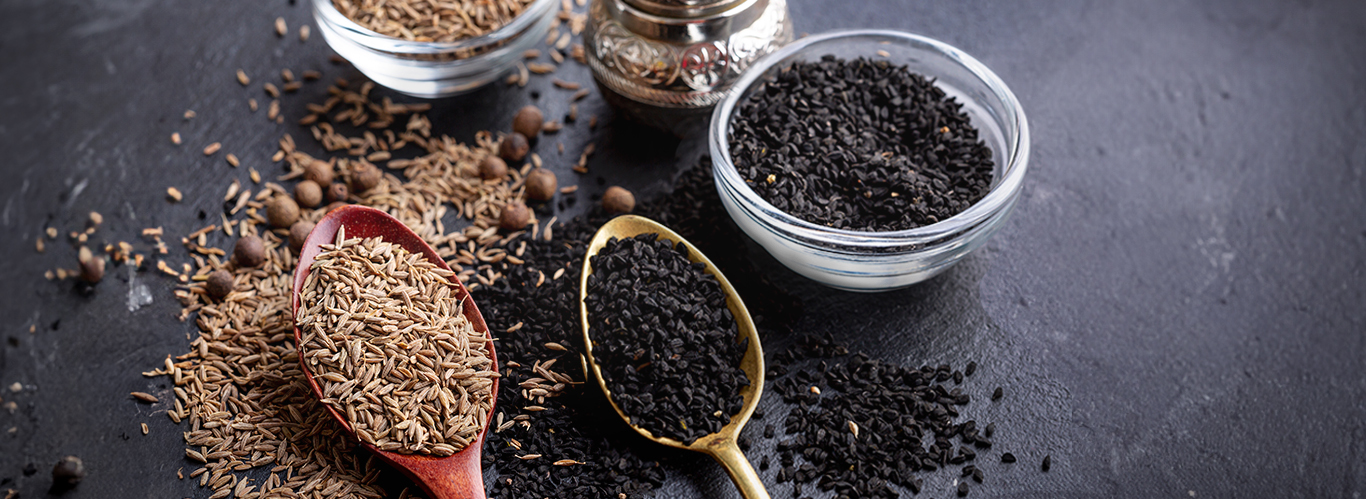Introduction
Ever been confused about cumin vs jeera, then you’re not alone. Many people believe that they are identical, just with different names. But did you know that both can be two different types of spices? One is the regular cumin you probably use daily, and the other is kala jeera, a darker and more intense version.
The difference between cumin and jeera isn’t just about looks—it’s about flavour, aroma, and how they work in cooking. If you're uncertain about jeera vs. cumin seeds, and which one to use for your recipes, this blog will guide you with the same.
What is Kala Jeera?
Kala jeera, also called black cumin or kalonji, is a spice that stands out because of its deep, earthy aroma. Unlike regular cumin, these seeds are smaller, darker, and slightly curved. They pack a punch in terms of flavour—raw, they taste slightly bitter, but once roasted or cooked, they develop a warm, slightly sweet note.
This spice is often used in slow-cooked dishes because the longer it cooks, the more its flavour unfolds. It’s a key ingredient in Mughlai dishes, biryanis, Mughlai paratha, and meat gravies. Kala jeera has a long history in traditional medicine, believed to aid in digestion and improve immunity, aside from being used as a cooking ingredient.
What is Regular Cumin?
Regular cumin, or jeera, is what most of us are familiar with. It has a warm, nutty, and slightly peppery taste that enhances everything from dals to curries. The seeds are light brown, elongated, and straighter compared to kala jeera.
Regular cumin is used in both whole and ground form. Many Indian households start their cooking by adding whole cumin seeds to hot oil—this simple step brings out an unmistakable depth of flavour. Ground cumin, or cumin powder, is equally versatile, often mixed into spice blends or sprinkled on chaat and salads.
Key Differences Between Kala Jeera and Regular Cumin
Let’s understand cumin seeds and jeera differences through 4 major categories:
1. Appearance
- Kala Jeera: Small, Black, slightly curved.
- Regular Cumin: Light brown, longer, and straighter in shape.
2. Flavor Profile
- Kala Jeera: Strong, slightly bitter when raw, but turns mildly sweet when roasted or slow-cooked.
- Regular Cumin: Warm, nutty, with a subtle peppery edge that works well in everyday cooking.
3. Culinary Uses
- Kala Jeera: Ideal for sabzi's, pickles, and slow-cooked dishes where its deep flavour can fully develop.
- Regular Cumin: Used in everyday dishes, from simple dal tadkas to stir-fries and spice blends.
4. Health Benefits
Both cumin and jeera have differences that extend to their health benefits:
- Kala Jeera: Known for aiding digestion, improving metabolism, and having antibacterial properties.
- Regular Cumin: Supports gut health, is rich in iron, and helps in reducing bloating and inflammation.
How to Use Kala Jeera & Regular Cumin in Cooking
Understanding when to use jeera vs cumin seeds can make all the difference in a dish.
Kala Jeera
- Works best when roasted before use.
- Ideal for dishes that require long cooking times, like biryanis, kormas, and slow-cooked meat curries.
- A small amount is enough because of its strong flavour.
Regular Cumin
- Versatile—can be used whole or ground.
- Perfect for quick-cooking dishes like dals, vegetables, and spice blends.
- Tastes great when tempered in oil at the beginning of cooking.
For instance, if you’re making a spicy pickle, Sunrise Kala Jeera adds an unmatched depth of flavour. But for daily cooking, like adding a warm, toasty note to your dal or sabzi, Sunrise Whole Jeera is your best bet. Pair it with Sunrise Black Pepper for an extra hint of spice and aroma.
Conclusion
Now that you know the cumin vs jeera seeds differences, it’s clear that each has its own special place in cooking. Kala jeera is perfect for dishes that need time to develop flavour, while regular cumin is a kitchen essential for everyday meals. Choosing the right spice ensures that your dish has the perfect balance of taste and aroma.
For premium-quality spices that bring out the best in your recipes, Sunrise Kala Jeera, Sunrise Whole Jeera, and Sunrise Black Pepper are must-haves in every kitchen. Whether you're preparing a homely dal or an aromatic biryani, the right ingredients make all the difference.
FAQs
1. Which is healthier—Kala Jeera or regular cumin?
Both have health benefits. Kala Jeera is great for digestion, while regular cumin is rich in iron and supports gut health.
2. How should these spices be stored?
Keep them in an airtight container, away from heat and moisture, to maintain their freshness.
3. What’s the best dish to use Kala Jeera in?
Pickles, Chutneys , and in gravies.
4. Can I use both Kala Jeera and regular cumin in the same dish?
Yes! Combining them in the right ratio can create a deeper, more complex flavour.
5. Is it possible to replace regular cumin with kala jeera?
It depends on the dish, as Kala Jeera has a stronger, slightly bitter flavour.
